Step 1: Create an account to get started
If you already have an account created on GoDaddy, there is no need to create a new one. Existing customers simply need to sign in before choosing a category and starting to use the website editor.
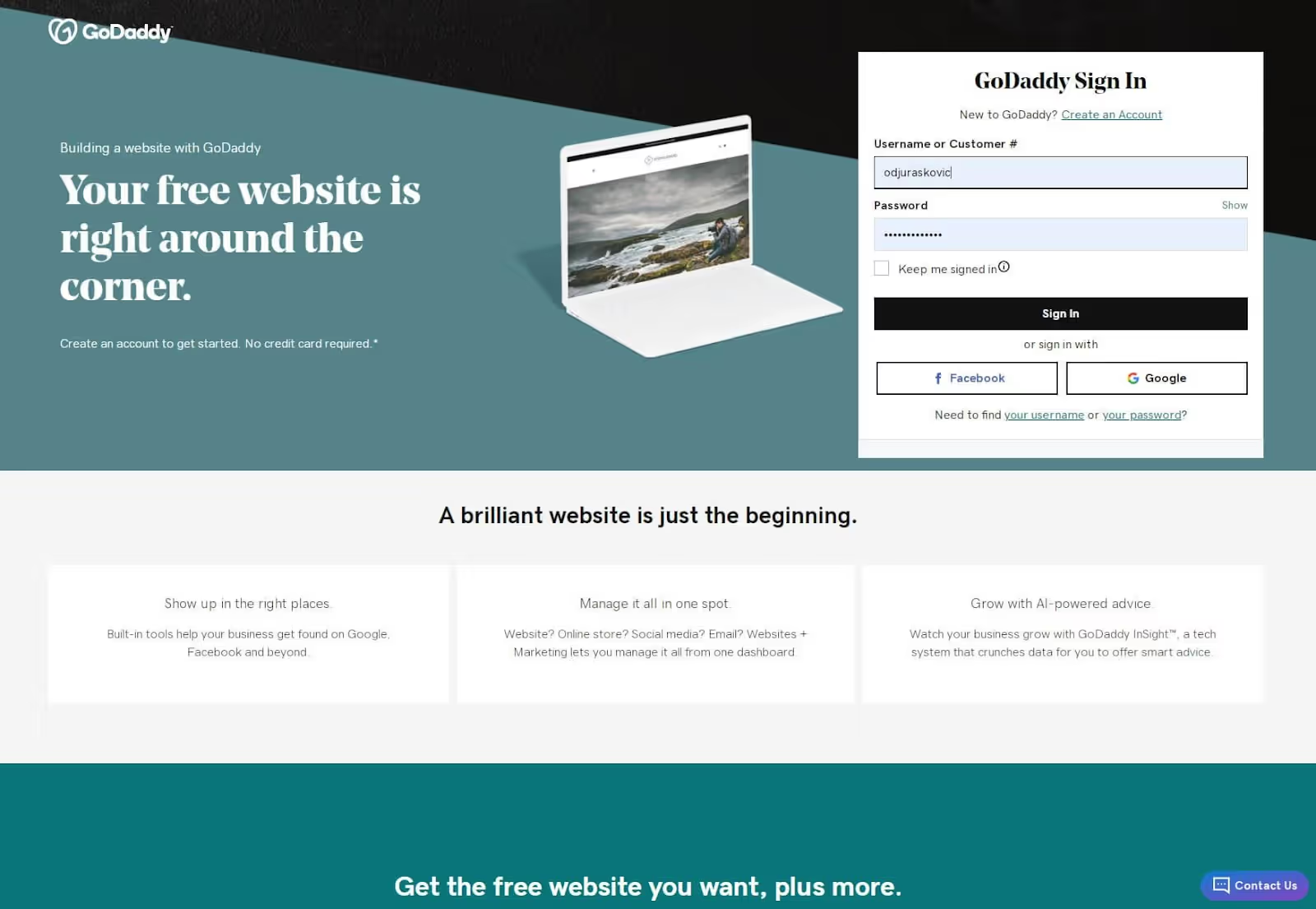
However, if you are a new user, you can create a new account within seconds.
The quickest way to do this is to sign in to your existing Google or Facebook account. GoDaddy will then gather all of the required information and create the account for you.
For those of you who don't have one of these accounts or just don't want to use them with GoDaddy, it's easy to enter your email address, username, and password to get started. A free 1-month trial is available, and you don't need to enter your credit card details to start building your free website.
- Go on GoDaddy.
- Enter your email address, desired username, and password.
- Choose to accept or decline to receive personalized offers.
- Click on the “Create Account” button to get started.
Step 2: Choose a category for your website.
After creating an account or signing in with an existing account, you can start building your first site. The first step is selecting a category.

You will be offered a selection of categories, but if you don't see the one that's right for your website, simply enter your category in the field below. While it may not seem essential to select a category at this point, be aware that GoDaddy uses this information to create an optional sample site that could give you a more leisurely start.
Step 3: Choose a name for your website
Obviously, the The name of a website is a crucial step. Register what you want, but don't worry if you haven't made a firm decision yet, as it's still possible to change your GoDaddy site name from settings in the future.
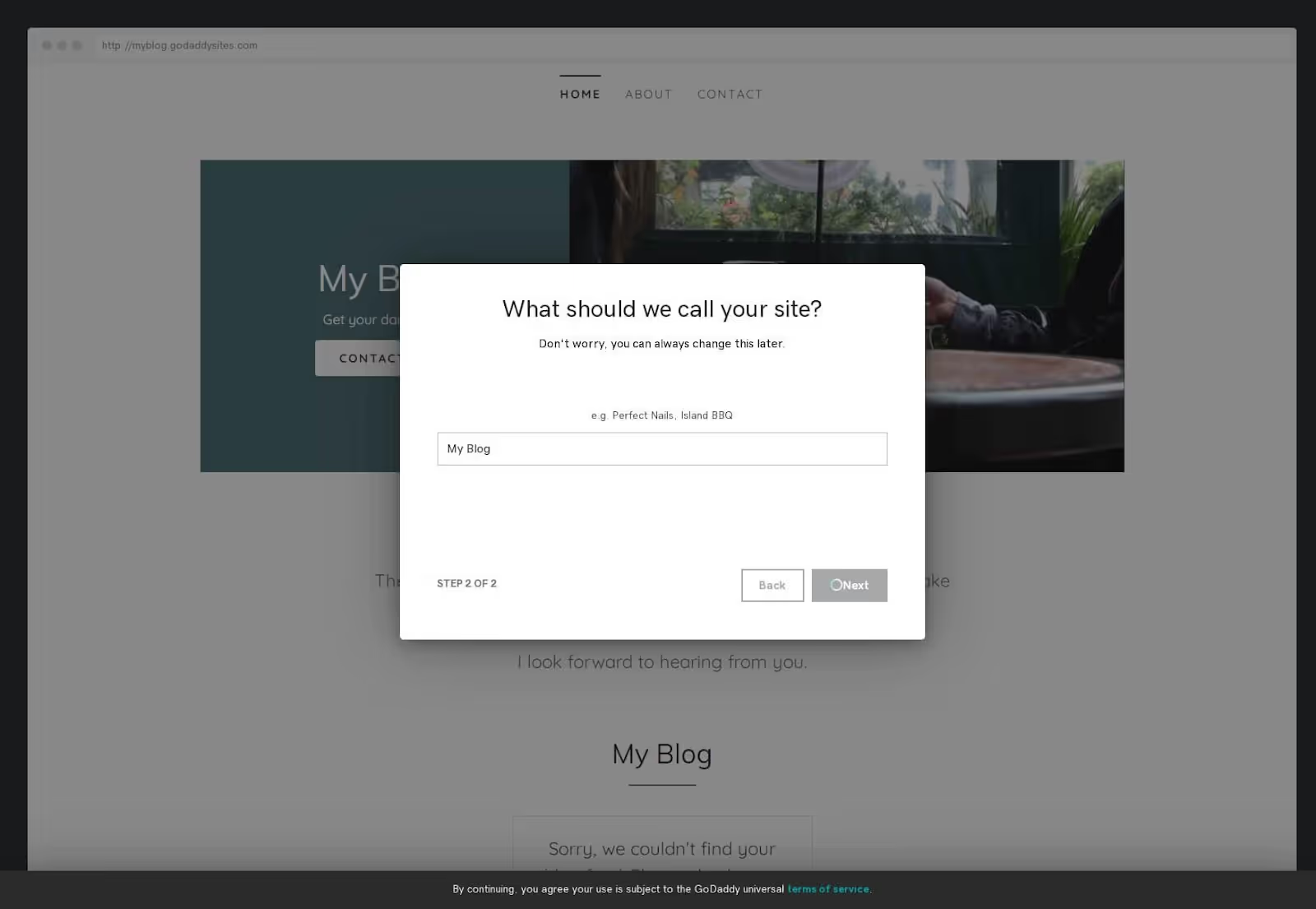
Step 4: Start editing and customizing your site.
After clicking the “Next” button, please wait a few seconds for GoDaddy to build your website. The results will vary depending on your selection of categories. And that's where the fun part starts — customizing your site and making things personal.
Choose a theme
Choosing a theme should be your first step in customizing your site. By clicking on the “Theme” tab located in the upper right corner of the GoDaddy site editor, you will have access to several options. You'll also notice that the editor zooms out of the view of your site on the left side of the screen so you can see how any changes affect the entire layout.
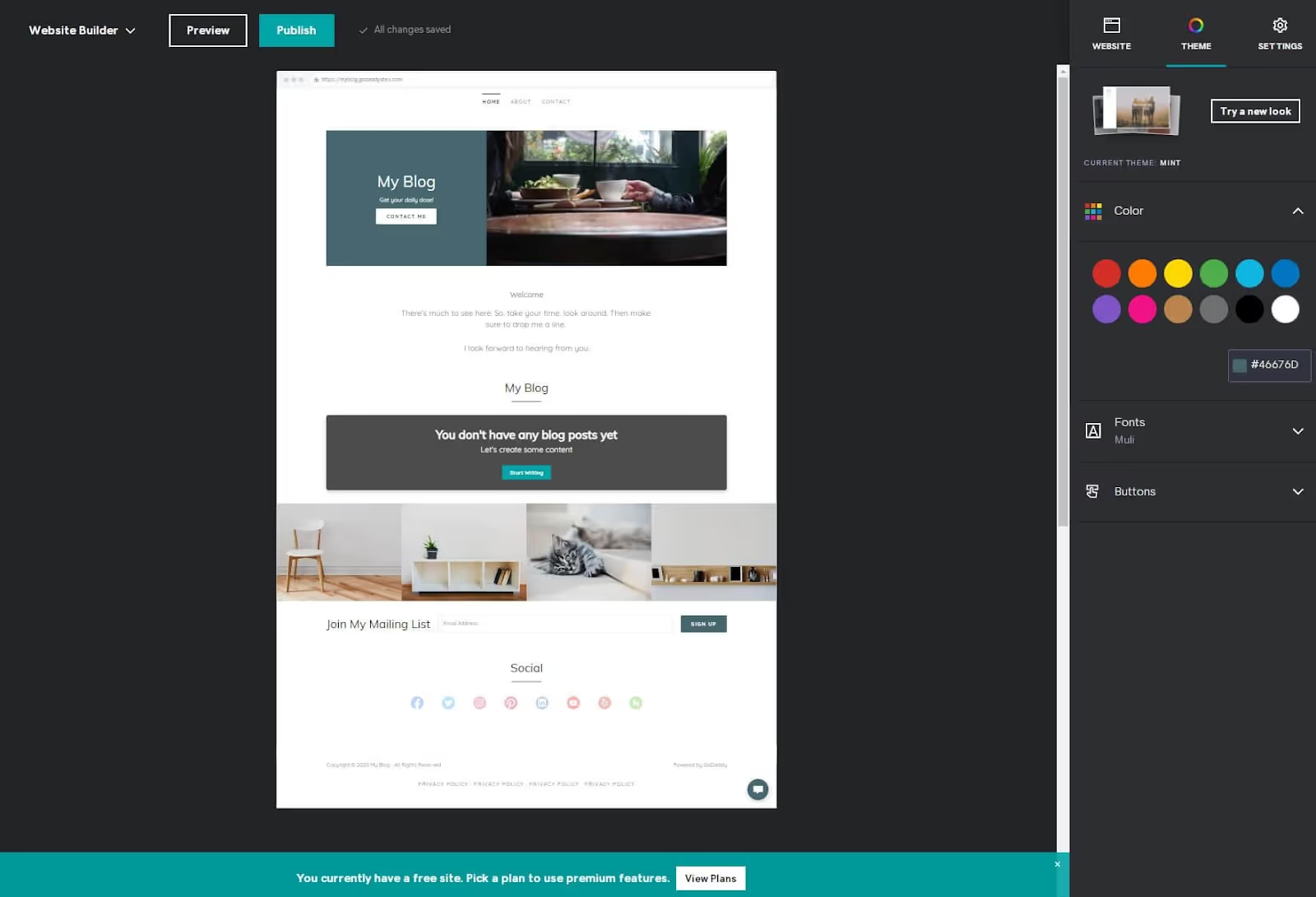
The first thing you'll see in the options is the current theme you're using. This is the one that GoDaddy selected based on your category. If you don't like this theme or just want to see what's available, click on the “Try a new look” button. There were just over twenty themes available when I tested the editor.
What's great is that the editor automatically loads your current content into all other examples when you select them, giving you an instant idea of a potential theme.
However, don't be afraid to click on a thumbnail you like, which will take you back to the editor. Preview your site, and if you still don't like it, you can always go back and select a different theme and continue working on your site without losing content.
Choose the color of the theme
The next step is choosing the color for your theme. This color will affect a few elements on your site, making it the main color of the site. Select one of the predefined colors or use a custom color by entering a hexadecimal code. Unfortunately, GoDaddy does not offer color picker, so you'll need to find the perfect color using a third-party color selection tool and copy the code here.
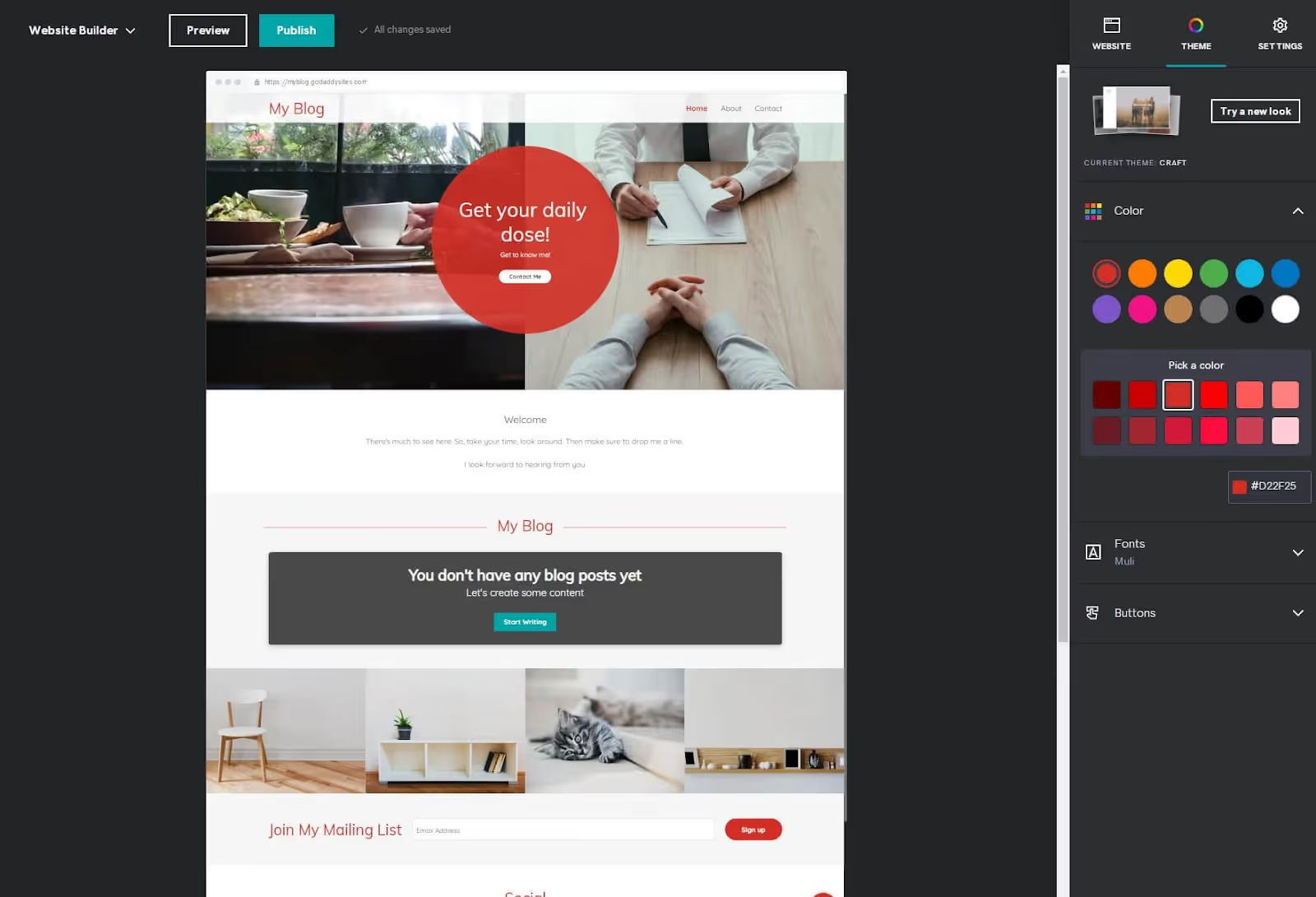
Choose the font and button design
To change the fonts on your site, click on the font options below. If you're not sure how the fonts work or how to combine them properly, simply choose one of the combinations GoDaddy has outlined. There are only a few dozen to choose from, but I'm sure you'll find one you'll like. For the more creative, click on the “advanced” tab and select separate primary and secondary fonts to further customize your site.
The last thing to personalize here are the buttons. Select options, then choose the design for your primary and secondary buttons. By default, the buttons will use the theme color you selected earlier, but if you want to avoid that, activate the “Use theme color” button, and they will turn white.

Once you've finished customizing the theme, it's time to start making the site more personal. And there's no better way to do that than by adding images and text.
Add images and text
In the upper right corner of the editor, choose the “Website” tab to bring your site back into focus. Move around your site and select items that contain images and text.
If you select the header section, you will find the “Update” button. Click on it, and the editor will show you the current image on the right side of the screen. You can choose to show an image or video in the background, upload a new photo, and zoom in or out until the image is exactly as you imagined.
When you click on an item that contains text, the editor loads it onto the right side of the screen. Here you can edit titles, descriptions, and write anything you want. Feel free to browse the other options, and change the layout, accent colors, and alignments.
Add pages and sections
The website you currently have in front of you is just the example page that the creator of GoDaddy created for you. You can always remove a section you don't like or need by selecting the three dots in the upper right corner of the selected item. And when you decide to add more content, you can easily add pages and sections.
- Select the “Website” tab in the right-hand side menu.
- To add a page, click on the “Add a page” link.
- Select “New Page.”
- Add a title.
- Decide if you want to show this page in the navigation, the footer, or make it private.
- Click on the “Create Page” button.
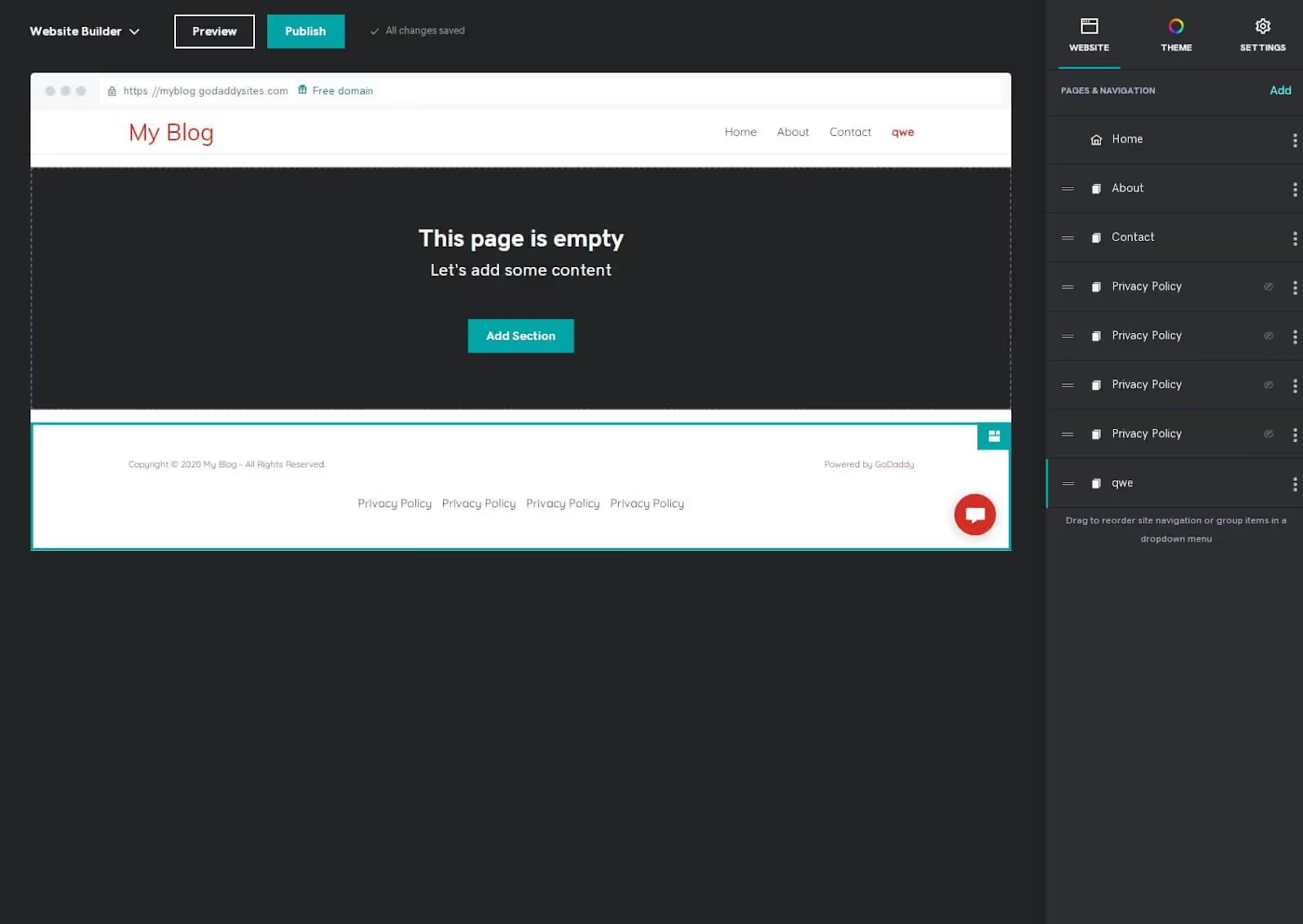
After a second or two, you will be able to see the new page loaded in the editor. It will be empty, but you can start adding new sections and content to it.
- To create a new section, click on the “Add a section” button.
- Choose a section you want to add, like content, photo gallery, video, and more.
- Select the module layout that works best for you.
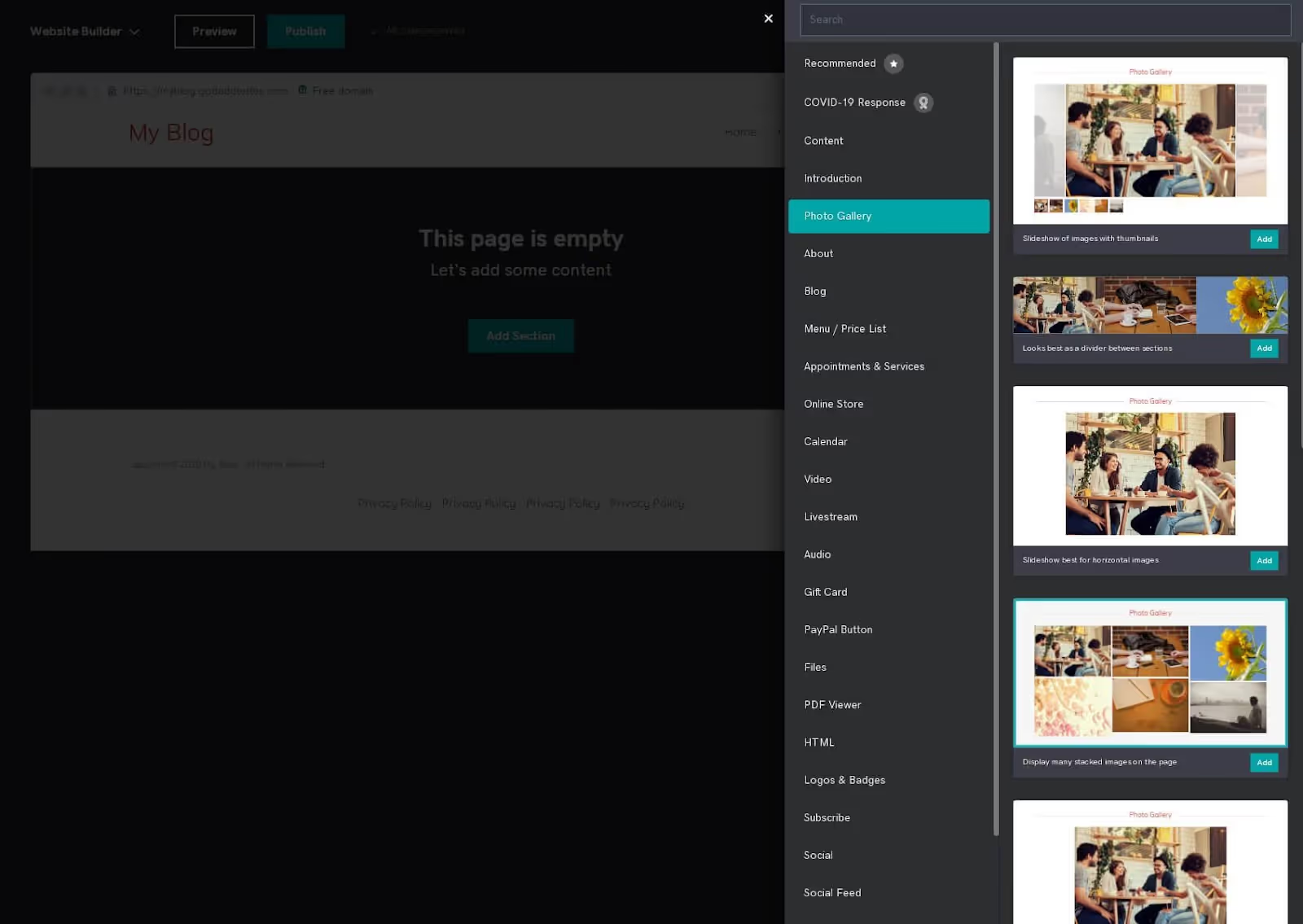
After that, the new section will be added to your page, and you can continue to edit it by clicking on the items and changing the content.
Review settings
The design of your website is important, but it can't function properly without having the right settings to control everything. To change your site settings, click on the “Settings” tab in the right-hand side menu of your editor.
- Basic information - change personal information such as site name, business category, email address, your physical address, and phone number.
- Social media links - add links to your Facebook, Twitter, Instagram, and several other popular social media sites.
- Favicon - download a custom icon to make your site look more professional. It is recommended to upload a square image that is 180px by 180px.
- Search engine optimization - write down a few keywords that describe your site. Here, you can write the title and description of each page on your site.
- Site history - reset your website if needed or create a backup. You can see the automatic backups that the editor creates when you change themes or make more critical changes.
- Cookie banner - change the banner that informs people about the use of cookies on your site.
- Google Analytics - if you have an account Google Analytics, this is where you need to connect it to your GoDaddy website so you can track how and when your customers navigate the site.
- Facebook Pixel - if you want to follow your site via Facebook Pixel to learn more about your audience, this is where you need to connect them to your website.
- Pinterest metatag - if you use Pinterest, you can add your meta tag here.
- Google AdSense - to make money with Google AdSense, you need to add your AdSense script in this field.
Complements to the website
In addition to the usual sections that you can add, GoDaddy allows you to add and control a few additional items to your site.
- Blog - this add-on controls your entire blog. It's the place where you can create a new post, manage comments, subscriptions, and anything else related to the blog.
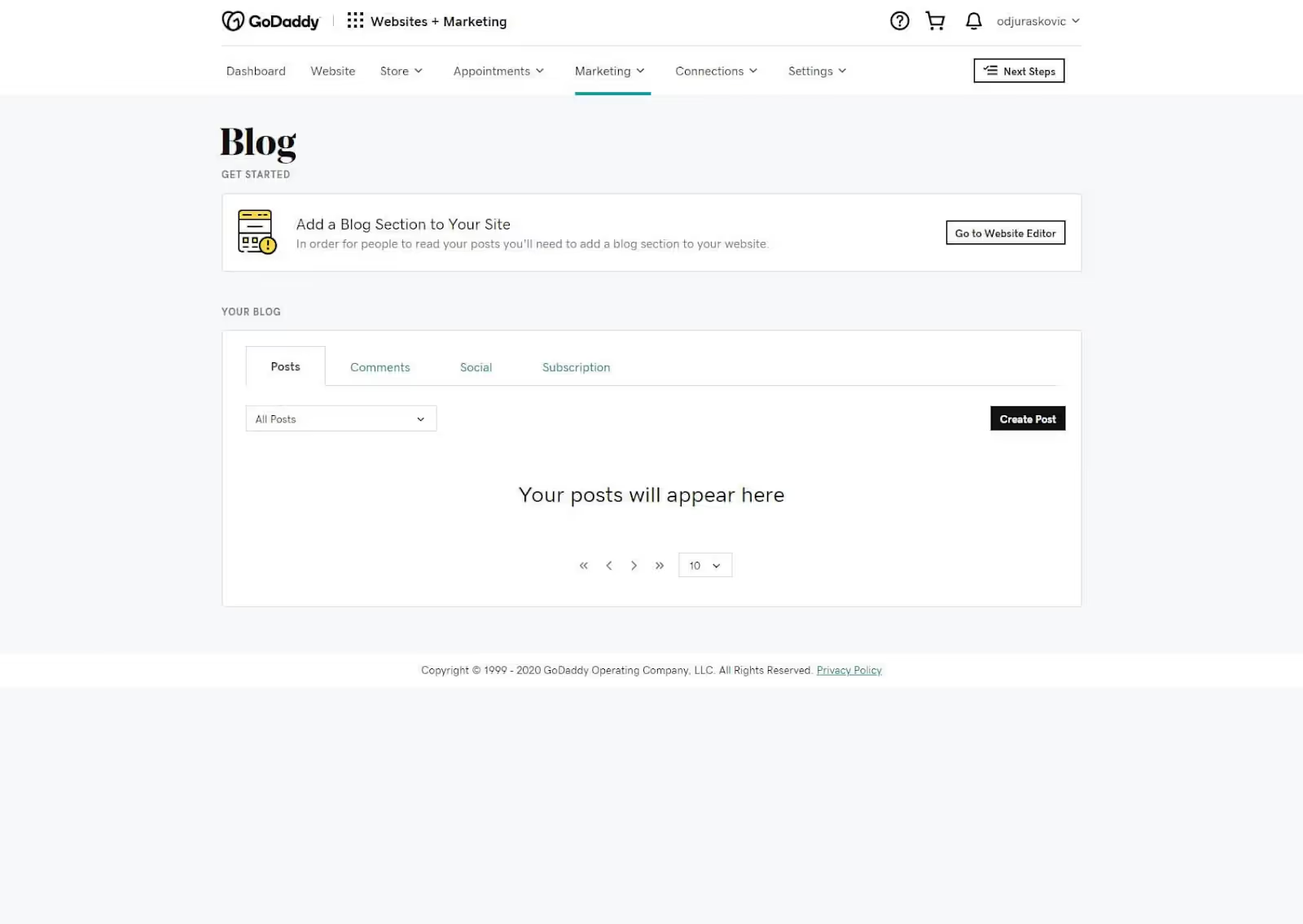
- Messaging - allows visitors to contact you directly from the site. If this option is enabled, visitors will see a form that they can use to send you a message. This is also where you can customize the welcome and thank you message that will be sent to people who contact you, as well as several other related options.
- Popup - create a popup window that will be displayed to visitors. Add an image, edit the content, and add action buttons.
Step 5: Optimize your website for SEO
At this point, you should have a custom site that looks good and contains images and content that make it personal. However, before making it public, you still need to make a few changes that will make your site compatible with Google.
- Open the “Settings” tab in the top right corner of your site.
- Choose “Search Engine Optimization.”
- Select a page to edit.
- Write a title and description.
By describing each page on your site, you make it better optimized for Google and other search engines. This makes it more likely that users will find your content through search engines. So be sure to describe each page well.
When you add images, you can also write their description and make them better for SEO.
Step 6: Previewing and Publishing Your Website
At any time while customizing your site, you can see what it looks like. If you click the “Preview” button in the top menu, you'll see what your site looks like on desktop as well as mobile devices.
This will allow you to make additional changes if needed and to know what visitors will see when they visit your domain name.
Once you have completely customized the site, you can publish it and make it available to the public by clicking on the “Publish” button.
Step 7: Upgrade to connect a custom domain
When you start out, your site will always be available at the following address: yoursite.godaddy.com. There's nothing wrong with that, but you might want a custom domain that will make your site look nicer and more professional.
- Go back to scorecard by selecting it from the menu in the upper left corner.
- Click on the “View plans” link at the top.
- Choose the plan you prefer and click “Add to cart.”
- Complete the purchase.
Pricing plans available
Base
$9.99 per month if paid annually
Secure your website, connect a custom domain, mobile-friendly site, editing on the go, 24/7 support, free business email address for one year, PayPal button, 1 social media and SEO platform, 5 social messages and social responses/month, 100 marketing emails/month.
Standard
$14.99 per month if paid annually
Secure your website, connect a custom domain, mobile-friendly site, editing on the go, 24/7 support, free business email address for one year, PayPal button, find yourself online (SEO), 3 social media and SEO platforms, 20 social posts and social responses/month, 500 marketing emails/month.
Premium
$19.99 per month if paid annually
Secure your website, connect a custom domain, mobile-friendly site, editing on the go, 24/7 support, free business email address for one year, PayPal button, find yourself online (SEO), unlimited social media and SEO platforms, unlimited social messages and social responses/month, 25,000 email marketing emails/month.
eCommerce
$24.99 per month if paid annually
Secure your website, connect a custom domain, mobile-friendly site, editing on the go, 24/7 support, free business email address for one year, PayPal button, find yourself online (SEO), unlimited social media and SEO platforms, unlimited social messages and social responses/month, 25,000 marketing emails/month, e-commerce options.
FAQs
Can I create my own website on GoDaddy for free?
GoDaddy offers a free trial that allows you to use the editor for one month at no charge. However, after this trial period, you will need to choose one of their paid plans in order to continue using the service and have your site online.
Is the GoDaddy website builder good for SEO?
GoDaddy's website builder only allows you to edit essential information. While that's enough to get you started, it's not suited to compete with more serious websites using other website builders. To get more SEO options, you'll need to upgrade your plan.
Which is better GoDaddy or Wix?
GoDaddy is a good website builder for people who want to create simple websites and don't expect much from them. Creating a site with GoDaddy can be done quickly, but it lacks a number of features compared to Wix. On the other hand, Wix comes with a drag & drop editor that allows you to show your creativity and offers a lot more features that will allow you to create a much better website.
Conclusion
If you are looking for a simple site editor that will allow you to create a simple website, GoDaddy is definitely the right choice. While it doesn't have all the bells and whistles like some competitors, creating a site with them is quick and easy.
Hopefully, this guide has helped you create your first GoDaddy website and that you are now more comfortable exploring all of the features. If you published your site, don't forget to add a link in the comments below, and show us what you did!

.svg)





